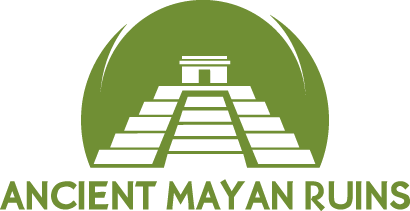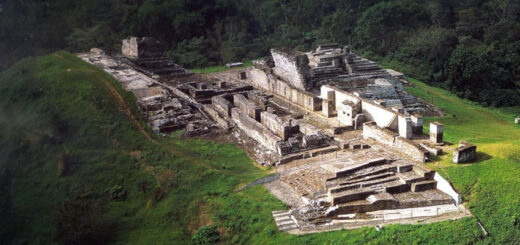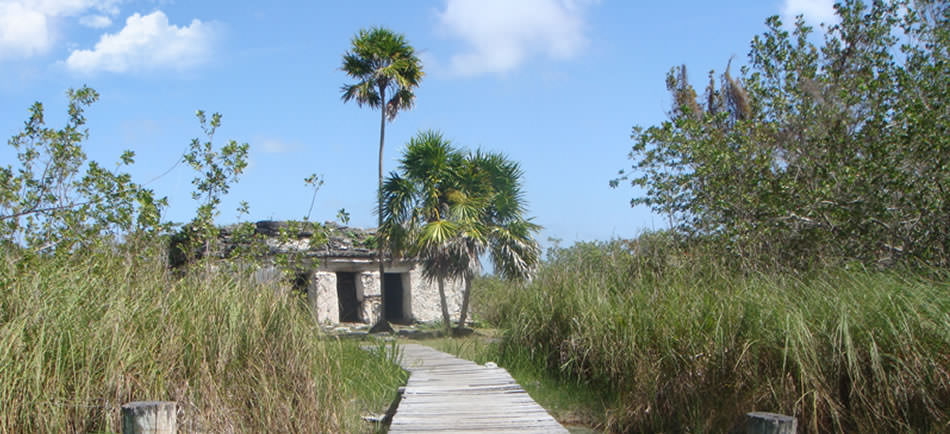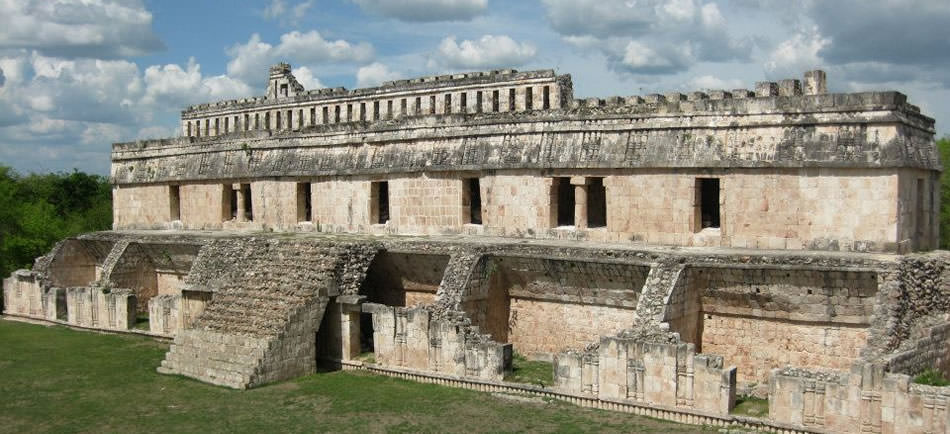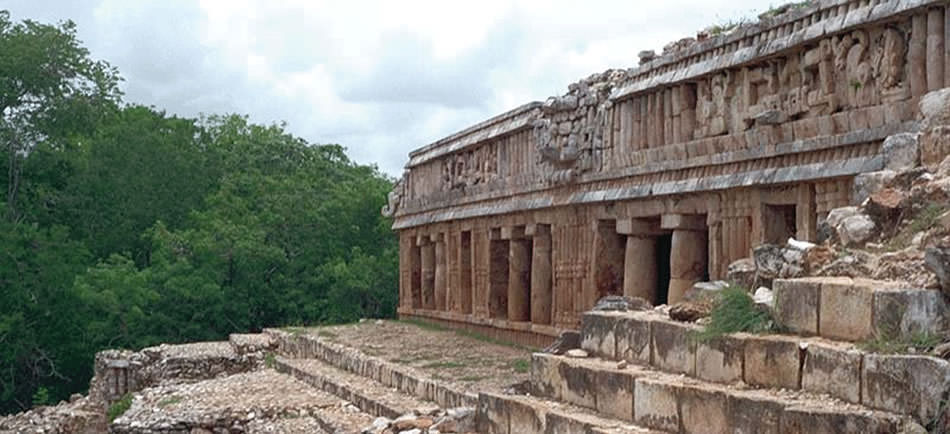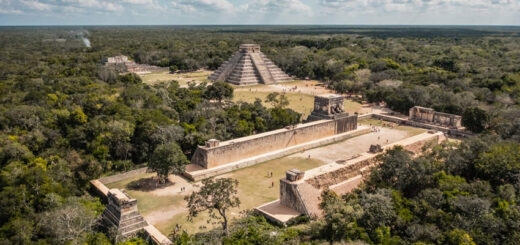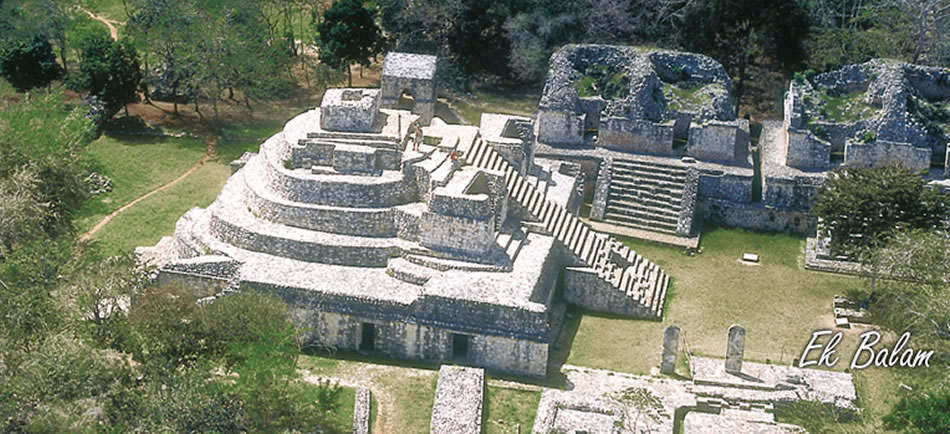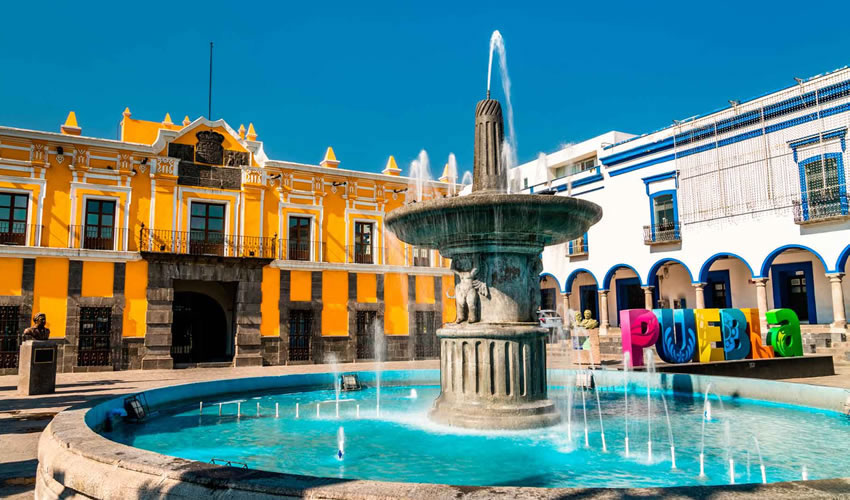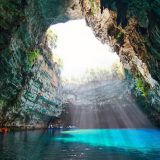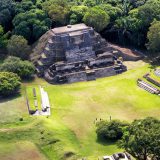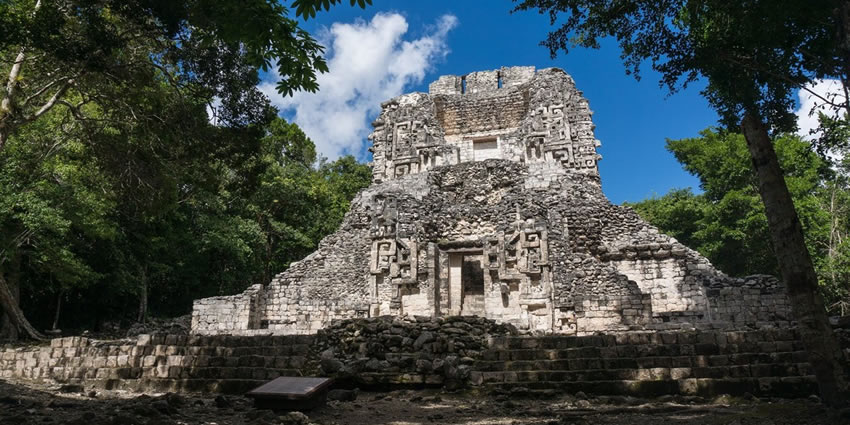
Chicanná
Chicanna is nestled in the heart of Mexico’s Yucatán Peninsula. Reaching the Chicanná archaeological zone is an adventure that takes you through some of the most picturesque landscapes of the Yucatán Peninsula.
The site offers a captivating glimpse into the ancient Maya civilization. Known for its intricate architecture and well-preserved structures, Chicanna is a must-visit for history enthusiasts and adventure seekers alike.
In the Yucatec Maya language, the word “Chicanna” means “House of the Serpent Mouth”. This name is fitting, given the site’s famous structure, which features a grandiose façade resembling a serpent’s open jaws.
Chicanna provides a serene and intimate experience and remains a captivating destination for those looking to delve into the mysteries of the ancient Maya while enjoying the tranquil beauty of the Mexican rainforest.
Highlights include the stunning “House of the Serpent Mouth,” a building adorned with intricate carvings that depict the jaws of a mythical serpent, a testament to the Maya’s rich mythological and symbolic traditions.
The Chicanná Archaeological Zone, with its exquisite architecture and serene ambiance, offers a memorable journey into the past, making it a must-visit for anyone interested in the rich history of this ancient world.
The journey to Chicanná ruins is filled with scenic beauty and the promise of exploring one of the Maya civilization’s most intriguing sites. The Chicanna archaeological zone promises an unforgettable journey into the past.
Geography and Environment
Chicanna is located in the southeastern part of Campeche and is part of the larger Rio Bec region, renowned for its unique architectural style characterized by tall, slender towers and elaborate stone facades.
The site sits amidst dense tropical forests that add to its mystique.
The surrounding jungle teems with wildlife, offering the chance to spot exotic birds, butterflies, and even the occasional howler monkey. The lush environment is a natural canopy that offers shade and keeps the area relatively cool.
Best Time to Visit Chicanná
Plan your trip during the dry season, from November to April. During these months, the weather is typically warm and pleasant, with minimal rainfall, making it ideal for exploring the ruins and the surrounding jungle.
The temperatures range from 20°C to 30°C, ensuring comfortable conditions for hiking and sightseeing. Avoid the rainy season from May to October, as heavy downpours make the terrain muddy and challenging to navigate.
History and Chronology
Preclassic Period (2000 BCE – 250 CE)
The earliest evidence of human activity in the Chicanna area dates back to the Preclassic period, although the site itself wasn’t fully established until later. During this time, the region saw the gradual development of agricultural practices and small, sedentary communities.
Classic Period (250 CE – 900 CE)
The Classic period marks the height of Chicanna’s cultural and architectural development. It was during this era that the site saw the construction of its most iconic structures, including the “House of the Serpent Mouth.”
The architecture from this period is characterized by elaborate facades and intricate stone carvings that reflect the artistic and engineering prowess of the Maya.
Early Classic (250 CE – 600 CE): Chicanna began to flourish as a significant center within the Rio Bec region. The early stages of monumental construction started, with the initial temples and residences being built.
Late Classic (600 CE – 900 CE): This era represents the zenith of Chicanna’s development. Major buildings and ceremonial complexes were constructed, showcasing the sophisticated urban planning and architectural styles distinctive to the Rio Bec region.
The influence of Chicanna extended through trade and political alliances with neighboring cities.
Postclassic Period (900 CE – 1500 CE): After the peak of the Classic period, Chicanna, like many Maya sites, experienced a decline. The reasons for this decline are debated, but it likely involved a combination of environmental changes, resource depletion, and social upheaval. By the end of the Postclassic period, Chicanna had been largely abandoned, with its remaining population dispersing to other areas.
Rediscovery and Modern Archaeology (20th Century)
Chicanna was rediscovered by modern archaeologists in the early 20th century.
Initial explorations and mappings were conducted by archaeologists such as Sylvanus G. Morley. Subsequent excavations have uncovered significant details about the site’s history, architecture, and the daily lives of its inhabitants.
Extensive archaeological work began in the 1970s, led by Mexican archaeologists and international teams. These excavations revealed the complexity and significance of Chicanna, highlighting its role within the broader context of Maya civilization.
Today, Chicanna stands as a testament to the ingenuity and resilience of the ancient Maya. The site’s preservation allows for a deeper understanding of the Maya’s rich cultural heritage and their lasting impact on the region.
Chicanná Archaeological Zone
The Chicanná Archaeological Zone is a relatively compact yet richly detailed site that offers a unique glimpse into the architectural and cultural sophistication of the ancient Maya civilization.
The site is known for its ornate stone carvings, particularly those depicting serpentine and zoomorphic figures. Set amidst a dense tropical forest, Chicanná provides an intimate and serene exploration experience, often without the crowds that frequent larger Maya sites.
Here are the key structures you should not miss:
Structure I (The House of the Serpent Mouth): The most iconic and well-preserved building in Chicanná, Structure I is renowned for its elaborate façade that resembles the open jaws of a mythical serpent.
This stunning entrance is a prime example of Rio Bec architectural style, featuring intricate stone carvings and mosaic panels that reflect the Maya’s artistic and symbolic richness.
Structure II: Structure II is another prominent building that showcases the Rio Bec style.
This structure includes a central staircase flanked by towers that were likely used for ceremonial purposes. The intricate stonework and decorative elements suggest it was an important building for religious or administrative functions.
Structure III: Located near Structure I, Structure III features a series of rooms arranged around a central courtyard. This layout is typical of Maya residential complexes and provides insight into the domestic life of the site’s inhabitants.
The structure’s walls are adorned with decorative elements, although not as elaborate as those in Structure I.
Structure XX: This building is distinguished by its unique architectural elements, including rounded corners and false stairways, which are characteristic of the Rio Bec style. It offers a glimpse into the architectural experimentation and innovation of the Maya builders.
Structure VI: Another notable building in Chicanná, Structure VI, features a multi-room layout with intricate stucco decorations and well-preserved carvings. It is believed to have served both residential and ceremonial purposes.
Structure XI: Structure XI is characterized by its tall, slender towers, which are a hallmark of Rio Bec architecture. These towers likely served a ceremonial or symbolic function, possibly representing mountains or sacred places in Maya cosmology.
Visitors to Chicanná will find well-marked paths and informative signage that provide context and history for each structure. The site’s compact size allows for a thorough exploration within a few hours, making it an ideal destination for a day trip.
How to get to Chicanná Ruins?
The nearest towns and villages:
- Xpujil is located just about 8 km away.
- Chetumal is approximately 120 km east of Chicanná.
- Escárcega is about 100 km northwest of Chicanná.
- Calakmul is around 30 km south of Chicanná.
Getting to Chicanná:
The drive from Xpujil to Chicanná is straightforward and takes about 10-15 min.
From Chetumal, the drive will take approximately 1.5 to 2 hours of amazing scenic views. There are also regular bus services run from Chetumal to Xpujil. Once in Xpujil, take a taxi or arrange for a local tour to Chicanná.
From Escárcega, the drive is about 1.5 hours. The road is in good condition and offers a pleasant drive through the rural areas. Buses also connect Escárcega to Xpujil, making it easy to continue your journey to Chicanná ruins.
Hire a guided tour:
Numerous tour operators based in Xpujil, Chetumal, and Escárcega offer guided tours to Chicanná. These tours include transportation, a guide, and sometimes additional visits to other nearby archaeological sites.
Tourist Information
- Balamkú Ruins are open to visitors from 08:00 to 17:00 daily.
- The entrance fee is generally modest, around 75 MXN (2024).
What to bring and what to wear?
- Bring water, as exploring the ruins is physically demanding.
- Light snacks or energy bars can help keep you fueled.
Opt for lightweight, breathable clothing to stay cool in the warm climate. Long sleeves and pants help protect against insect bites and sun exposure. A wide-brimmed hat and sunglasses will protect you from the sun.
Wear sturdy, comfortable shoes suitable for walking and climbing.
- Remember to respect any rules regarding photography.
- Bring insect repellent to avoid mosquito bites.
- Apply sunscreen generously to protect your skin from UV rays
